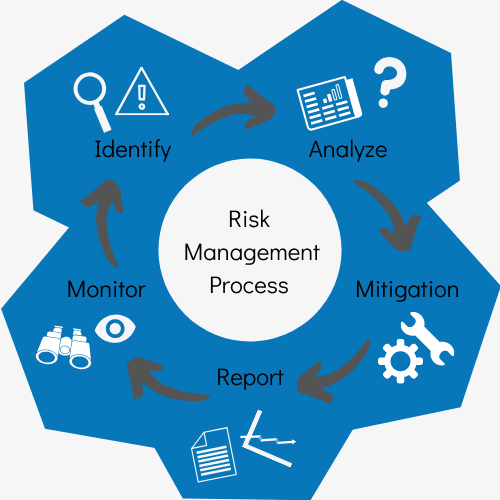How the Importance of Risk Management Shapes Effective Leadership
How the Importance of Risk Management Shapes Effective Leadership
Blog Article
The Critical Value of Risk Management in Achieving Organizational Objectives
In the rapidly evolving company landscape, the ability to navigate uncertainty has come to be a necessary. This is where Risk Management steps in, supplying an organized method to identifying, examining, and mitigating prospective roadblocks to advance. It's even more than just a protective action - it's a calculated tool, cultivating resilience and innovation. As we discover the important role of Risk Management in accomplishing business objectives, one can not help however question: just how does this translate into real-world success?
Understanding the Principle of Risk Management in Service

The Important Function of Risk Management in Strategic Planning
Integrating Risk Management right into strategic preparation acts as a secure for companies, securing their long-lasting plans with a strong foundation of readiness and resilience. It runs as the organization's radar, detecting potential hazards and susceptabilities that could disrupt the course in the direction of achieving their stated objectives. Risk Management uses a structure for anticipating unpredictabilities and creating ideal feedbacks, making sure the organization's survival and prosperity even when faced with misfortune. By including Risk Management right into strategic planning, organizations can transform these uncertainties right into opportunities for development and technology. This calculated interweaving of Risk Management promotes versatility, making companies more robust and enabling them to navigate the ever-changing service landscape with confidence. As a result, Risk Management comes to be an indispensable tool in calculated planning, important in protecting lasting success.

Methods for Identifying, Assessing, and Prioritizing Dangers
Navigating the facility landscape of dangers needs the application of certain methods for their recognition, evaluation, and prioritization. The procedure starts with Risk recognition, employing devices such as SWOT analysis, which assists in determining prospective hazards and chances. Next off, Risk assessment is carried out to ascertain the possible impact and likelihood of each Risk. Tools such as Risk matrices and impact-probability charts are utilized for this. Risks are focused on based on their possible effect and likelihood, allowing organizations to concentrate their sources on high-priority risks. This methodical approach makes certain an extensive understanding of the Risk landscape, making it possible for organizations to make enlightened decisions and successfully handle dangers to accomplish their objectives - importance of risk management.
Guarding Business Operations With Reliable Risk Management
In business landscape stuffed with unpredictabilities, efficient Risk Management plays a pivotal function in guarding organizational operations. It acts as a protective shield, find mitigating the unfavorable impacts of possible dangers and ensuring the smooth performance of all processes. By recognizing and assessing potential risks, Risk Management enables companies to check over here establish durable contingency strategies. This preventative strategy aids in keeping functional security, even when confronted with unexpected circumstances. In essence, Risk Management is the lifeline that maintains the organizational procedures afloat amidst rough waters. It ensures not just the survival however the sustainable development of an organization, making it a crucial tool in achieving company goals. Companies should spend in extensive Risk Management approaches to safeguard their operations.

Transforming Potential Dangers to Opportunities: The Power of Risk Management
A positive strategy to risk Management involves determining, evaluating, and prioritizing dangers to design strategies that turn them into prospective advantages. Therefore, by leveraging the power of Risk Management, companies can not just a fantastic read safeguard their procedures but also spur development and achieve their objectives in an uncertain service environment.
Situation Studies: Success Stories of Risk Management Driving Business Objectives
Successful implementation of Risk Management techniques has actually generated remarkable outcomes in numerous businesses, highlighting the qualities of this approach. Multinational firms like Microsoft and Google, for circumstances, have leveraged Risk Management to reduce threats and make use of chances, driving their company purposes onward. These instances highlight how successful Risk Management can not just steer services clear of prospective pitfalls yet likewise lead them in the direction of their strategic purposes.
Conclusion
To conclude, Risk Management is basically vital in accomplishing business objectives. It provides a systematic strategy to determining, assessing, and resolving potential hazards and opportunities. More than simply mitigating threats, it additionally cultivates technology, resilience, and sustainable development. By integrating Risk Management into calculated preparation, organizations can better navigate unpredictabilities, secure operations, and capitalise on possibilities, therefore aligning with long-lasting purposes.
At its core, Risk Management is the procedure of recognizing, assessing, and attending to prospective dangers that can negatively impact an organization's procedures or purposes. Next, Risk evaluation is performed to identify the prospective influence and likelihood of each Risk. Threats are prioritized based on their prospective effect and chance, allowing companies to focus their sources on critical risks. By determining and assessing prospective dangers, Risk Management enables organizations to develop robust contingency strategies. A proactive strategy to risk Management includes identifying, analyzing, and prioritizing dangers to create strategies that turn them right into potential benefits.
Report this page